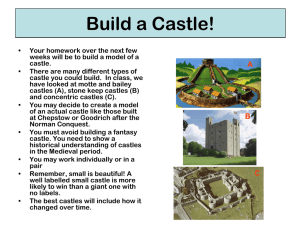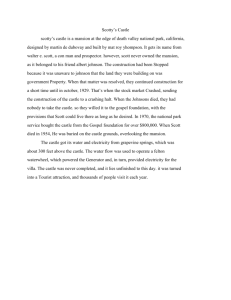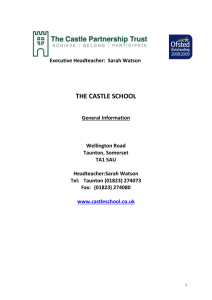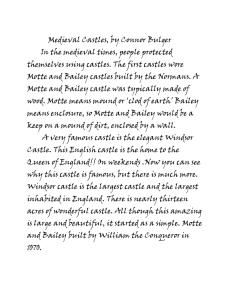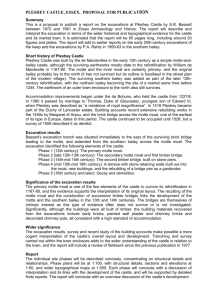How Cambridge YACs did it session 1
advertisement
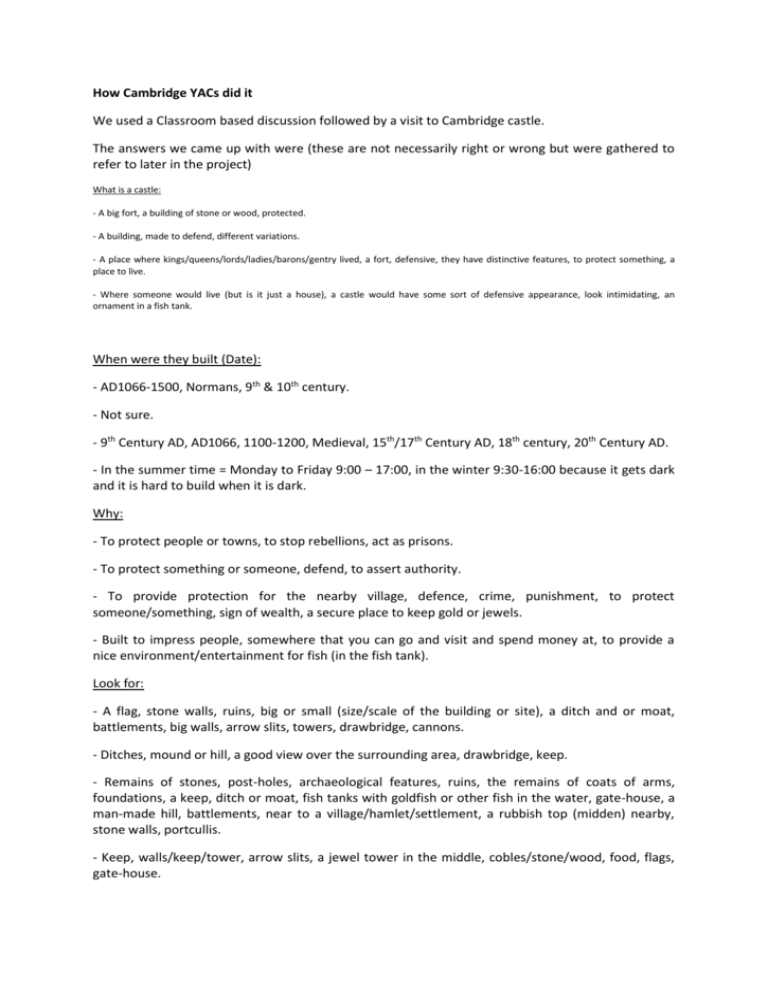
How Cambridge YACs did it We used a Classroom based discussion followed by a visit to Cambridge castle. The answers we came up with were (these are not necessarily right or wrong but were gathered to refer to later in the project) What is a castle: - A big fort, a building of stone or wood, protected. - A building, made to defend, different variations. - A place where kings/queens/lords/ladies/barons/gentry lived, a fort, defensive, they have distinctive features, to protect something, a place to live. - Where someone would live (but is it just a house), a castle would have some sort of defensive appearance, look intimidating, an ornament in a fish tank. When were they built (Date): - AD1066-1500, Normans, 9th & 10th century. - Not sure. - 9th Century AD, AD1066, 1100-1200, Medieval, 15th/17th Century AD, 18th century, 20th Century AD. - In the summer time = Monday to Friday 9:00 – 17:00, in the winter 9:30-16:00 because it gets dark and it is hard to build when it is dark. Why: - To protect people or towns, to stop rebellions, act as prisons. - To protect something or someone, defend, to assert authority. - To provide protection for the nearby village, defence, crime, punishment, to protect someone/something, sign of wealth, a secure place to keep gold or jewels. - Built to impress people, somewhere that you can go and visit and spend money at, to provide a nice environment/entertainment for fish (in the fish tank). Look for: - A flag, stone walls, ruins, big or small (size/scale of the building or site), a ditch and or moat, battlements, big walls, arrow slits, towers, drawbridge, cannons. - Ditches, mound or hill, a good view over the surrounding area, drawbridge, keep. - Remains of stones, post-holes, archaeological features, ruins, the remains of coats of arms, foundations, a keep, ditch or moat, fish tanks with goldfish or other fish in the water, gate-house, a man-made hill, battlements, near to a village/hamlet/settlement, a rubbish top (midden) nearby, stone walls, portcullis. - Keep, walls/keep/tower, arrow slits, a jewel tower in the middle, cobles/stone/wood, food, flags, gate-house. - Do they sell postcards? Is there a sign that says ‘castle’? Is there a charge to get in? Are there lots of small children holding wooden swords? Other types of archaeological sites that might confuse us and/or sites that look quite different but had similar functions: - Forts, Bunkers. - Burial mounds might look like a motte, Churches and Cathedrals were also built to look powerful/impressive. - Burial mounds, a fort – why they were only inhabited by soldiers, religious sites/buildings. - Stately homes have a similar function as they look grand in scale and help to raise money for English Heritage. The duration of our session was two hours class room work with an additional site visit. The County archaeologist attended our first site visit and provided a specialist guided tour. We selected a site that had some classic Norman castle features (motte and bailey). This was Cambridge Castle. We introduced the group to the term ‘topography’ as we started the site visit. We stood on the pavement at the top of Castle Hill and looked at the slope of the road as it heads down to the river. We also used this opportunity to discuss the name of the road and the clue that is gave us that a castle was probably somewhere nearby. The road name would be on the road sign at each end of the road, it would appear on street maps and we could look on OS maps and other old maps to see if the castle was shown on these. We learnt that it would take c. X soldiers to hold the castle and if it came under attack that their task was to hold the castle safe while someone else slipped out of the castle and rode off to get help so that more soldiers could come to assist in defending the site. We learnt that the Castle was an administrative centre for Cambridge and a focus of power. We were told that the defences were adapted during the civil war and we walked over to where one of the cannon’s would have been positioned. More recently there has been a prison within that area of the original Norman bailey and the foundations of this prison can occasionally be seen as crop marks in the grass lawn. The County Council’s Shire Hall is on the site today. It is interesting that the site has remained the focus of administration for Cambridge since the Normans conquered the England. At the top of motte is a square of concrete with a metal ring set into the centre. Our group was very interested in what the ring and concrete were for and how old they were. Someone suggested that it might have been to cap the top of a well to stop people from falling down the well. We were told that it was a modern addition to the site and added for health and safety. The sides of the motte are very steep, when grounds-men cut the grass that covers the slopes they attach their safety harnesses to the metal ring in order to prevent them from falling to the bottom. Cambridge Castle is a Scheduled Ancient Monument. We learnt that this means that the site has special protection in law.


